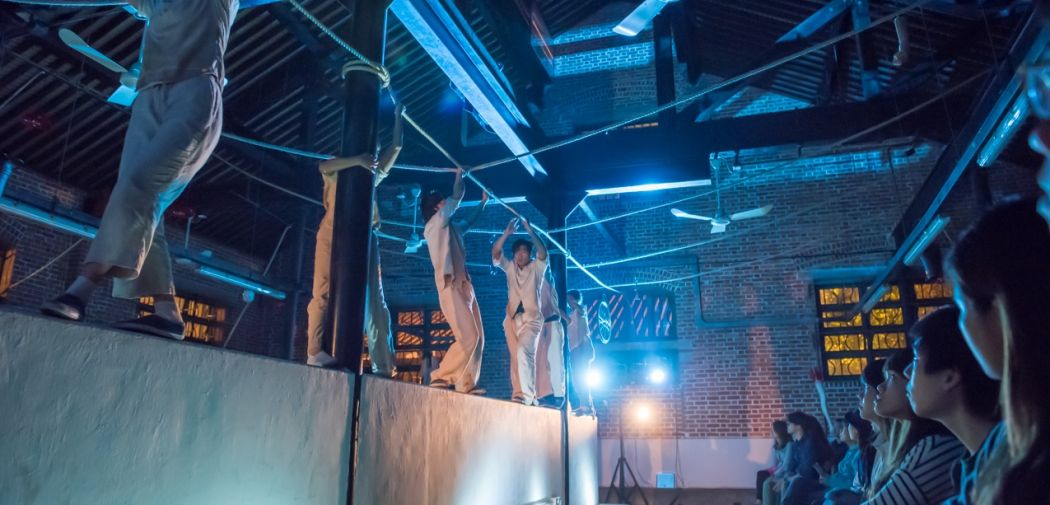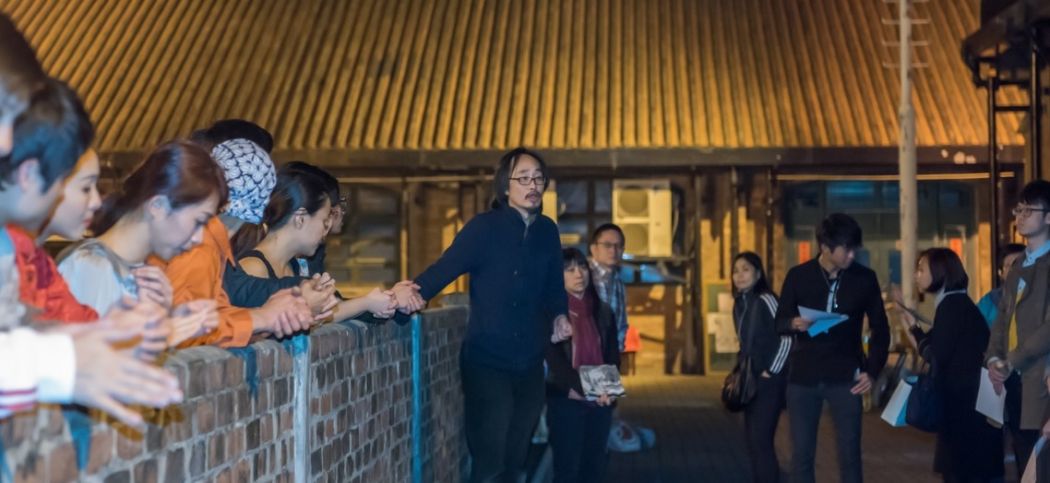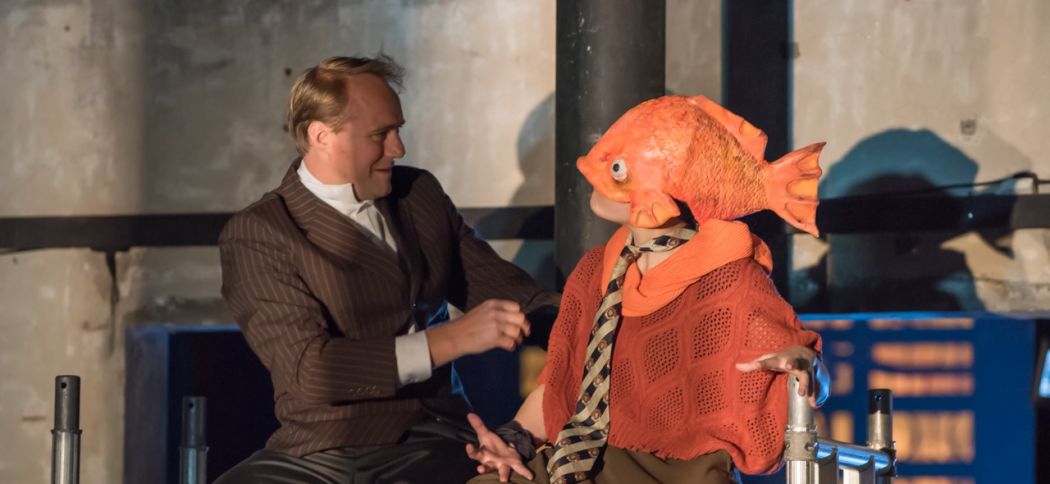The year was 411 AD: Guangzhou-based official Lu Xun led a 100,000-strong rebellion against the Eastern Jin dynasty. He managed to reach as far north as the Yangtze River, but was eventually defeated, and fled southwards towards the Chinese and Vietnamese coast.
Some of his troops settled on Lantau Island, in modern-day Hong Kong, and resorted to dwelling in caves and fishing for food. It has been said in a local myth that over the years, they turned into a fish-headed species of mermen called the Lu-ting.
Symbolising the people of Hong Kong, a merman named Lu-ting is now the main character in a physical theatre trilogy – Century-old Dreams of a Fishing Harbour – that narrates the city’s 175-year history, from its cession to Britain up to the present day. It is the brainchild of local group Theatre Horizons, who began performing the second of the three episodes – Nightmares – at the Cattle Depot Artist Village in To Kwa Wan last week.
Through the bulging fish-eyes of Lu-ting, this episode depicts the development of Hong Kong identity through the years 1941–1997 – beginning with the Japanese invasion, contemplating events such as the 1967 riots and the Tiananmen massacre, and closing with the handover. While Nightmares is undoubtedly small and non-mainstream, it is also significant because of its ambition – to condense 50 years of local history into two hours – a task that museums and documentaries might struggle to complete.

The result of this ambition is an intense sensory assault that utilises a myriad of experimental techniques. As an interactive theatre production, actors run, jump and dance not only in the centre, but also among the audience in the ‘seating area’ and even further into the periphery. There are spoken passages in five languages – often simultaneously – requiring viewers to glance back and forth between the subtitles (displayed on their very own smartphones) and the movement around them. Moreover, the production demands from its audience an understanding of both historical and (anachronistic) popular culture references in Hong Kong, such as Japanese pornographic actresses.
The central ‘stage’ is actually a giant wall – an existing structure inside Unit No. 12 of the Cattle Depot – that splits the audience into halves. Speaking to HKFP, director Chan Chu-hei likened the wall to a timeline, but also to the sharp division within Hong Kong society today. “Each audience member experiences the historical events differently depending on vantage point, and it takes several viewings to fully grasp every nuance in the production.”
A local theatre veteran, Chan delivered the first episode of the trilogy last year at the auditoria of the Tsuen Wan and Shatin Town Halls, but was dissatisfied with the formality of the environment. “We originally thought of performing Nightmares in an abandoned factory, but there was no chance we could have obtained a license from the Leisure and Cultural Services Department,” he says.
“Then we stumbled across the Cattle Depot, which is significant because the buildings here are also over a century old.” A slaughterhouse from 1908 to 1999, the site is now used as a workshop by around 20 artists’ groups, and often hosts exhibitions and performances.

Chan was not the first director to employ the Lu-ting creature as a symbol of Hong Kong. He traces the idea to Hong Kong Reincarnated, an exhibition by curator and scholar Oscar Ho Hing-kay, which opened on the eve of the handover on June 30, 1997. During the protests against national education in 2012, Chan and Theatre Horizons were inspired to create a theatre piece on the history of the city. The group, established six years earlier, had already achieved local fame for unearthing young talent and delivering performances on social issues.
The resulting production, however, was not Century-old Dreams of a Fishing Harbour – at least not yet. They wrote a play called The Lu-Tings, which can be considered as a “prelude” to the Century trilogy and premiered at the Edinburgh Arts Festival in August 2014. Chan felt that Hong Kong, as an international city, needed to be more confident in bringing its own mythology and folklore to an international audience, instead of adopting foreign arts and culture uni-directionally.
Though audience numbers were small, The Lu-Tings received positive reviews. The final act featured the performers lifting an umbrella in protest – an eerie prophecy of what was to come in the Umbrella Revolution merely one month later.

While The Lu-Tings exported the stories of Hong Kong to an international audience, Nightmares brings an international cast to Hong Kong. British theatre actor Nicholas Atkinson witnessed the handover of Hong Kong first-hand in 1997, as his father was posted to the city. In Nightmares, he portrays a series of archetypical colonial governors as well as former Prime Minister Margaret Thatcher.
Asked about his characters, Atkinson drew attention to Thatcher’s 2007 interview with businessman David Tang, where she expressed “regret” over the fate of Hong Kong, but was left with no option as “people would not have liked [Britain to intrude]”. This sentiment is heavily reflected in the dying moments of Atkinson’s performance.
It is his first time working in a local production, and he adds that the experience has helped him to understand the historical events from a local perspective.

Debriefing audience members after the show, Chan recalled that the rehearsals for the first two episodes of Century took place in a very sombre atmosphere. The first coincided with the Umbrella Revolution, and the second with the Fishball Revolution.
Theatre Horizons will soon begin work on the final episode, which will recount the story of Hong Kong from 1997 to the present day. It is expected to hit the stage in 2017, the symbolic year in which universal suffrage was meant to have been granted to Hong Kong. “If universal suffrage had been achieved, we would have ended the trilogy on an optimistic note,” explains Chan.
Theatre-goers, therefore, will know what not to expect.
Century-old Dreams of a Fishing Harbour – Episode II: Nightmares is staged every night 8pm at Unit No. 12 of the Cattle Depot Artist Village until March 13th.
